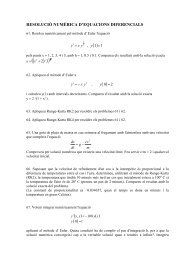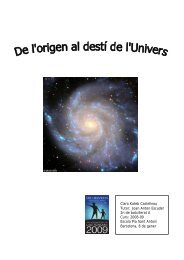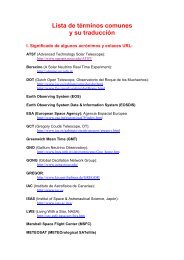Universitat de - Departament d'Astronomia i Meteorologia ...
Universitat de - Departament d'Astronomia i Meteorologia ...
Universitat de - Departament d'Astronomia i Meteorologia ...
You also want an ePaper? Increase the reach of your titles
YUMPU automatically turns print PDFs into web optimized ePapers that Google loves.
3.6. Discussion 109<br />
experienced a highly asymmetric SN explosion (Tauris et al. 1999). Unfortunately,<br />
the nature of the compact object in LS 5039 still remains unknown. However, we<br />
can try to study it in the symmetric SN scenario.<br />
Let MX and MO be the masses of the compact object and the optical companion,<br />
respectively. Taking into account the stellar evolution tracks by Schaerer et al.<br />
(1996), we can assume that MO 40 M⊙. Consi<strong>de</strong>ring that it must rotate slower<br />
than the breakup speed, and using the mass function f(m) = 0.00103±0.00020 M⊙<br />
by McSwain et al. (2001), an upper limit of MX < 9 M⊙ is obtained. The minimum<br />
mass for the compact object would be that of a neutron star of the Chandrasekar<br />
mass, MX > 1.4 M⊙. Hence, a total mass of ∼ 41–49 M⊙ remains in the system.<br />
Since the actual eccentricity of the system is e = 0.41 ± 0.05, and has a short<br />
orbital period of P = 4.117 ± 0.011 days, both parameters are expected to <strong>de</strong>-<br />
crease with time due to tidal forces which act to re-circularize the orbit. Hence,<br />
the eccentricity just after the SN explosion was epost−SN > 0.41. Using the equation<br />
∆ M = epost−SN (MX + MO) and MX = 1.4 M⊙ we find that at least 17 M⊙ were<br />
lost in the SN explosion in the symmetric case. If we adopt MX = 9 M⊙ the min-<br />
imum mass loss is 20 M⊙. Moreover, in or<strong>de</strong>r to have the system bound after the<br />
explosion, i.e., epost−SN < 1, the mass loss during the SN event must be less than<br />
the remaining mass in the system, i.e., < 49 M⊙. Hence, the values for the reduced<br />
mass of the system, <strong>de</strong>fined as µ = 1/(1 + epost−SN), range from 0.5 to 0.7. Using<br />
Eq. (5) of Nelemans et al. (1999) with the actual values of P and e we find that<br />
the re-circularized period will be Pre−circ 3 days. Since the period of the initial,<br />
pre-SN, binary system is given by Pi = µ 2 Pre−circ, the orbital period before the SN<br />
explosion was in the range 0.8 to 1.5 days. Using Kepler’s third law and assuming<br />
the latter value to allow the maximum separation possible between the progenitor<br />
stars, initial total masses between 60–100 M⊙ lead to semimajor axis in the range<br />
22–26 R⊙. This means that the two stars did not evolve separately, but probably<br />
through a common envelope phase. Hence, a <strong>de</strong>tailed evolution of the system should<br />
be carried out in or<strong>de</strong>r to try to compute the initial mass of the progenitor star of<br />
the compact object, the maximum age of the system before the SN event, and the<br />
mass loss during the SN explosion itself. This kind of study is beyond the scope of<br />
this work.<br />
Nevertheless, we can try to explain the measured vsys in the context of the<br />
symmetric SN explosion scenario using the following equation from Nelemans et al.






